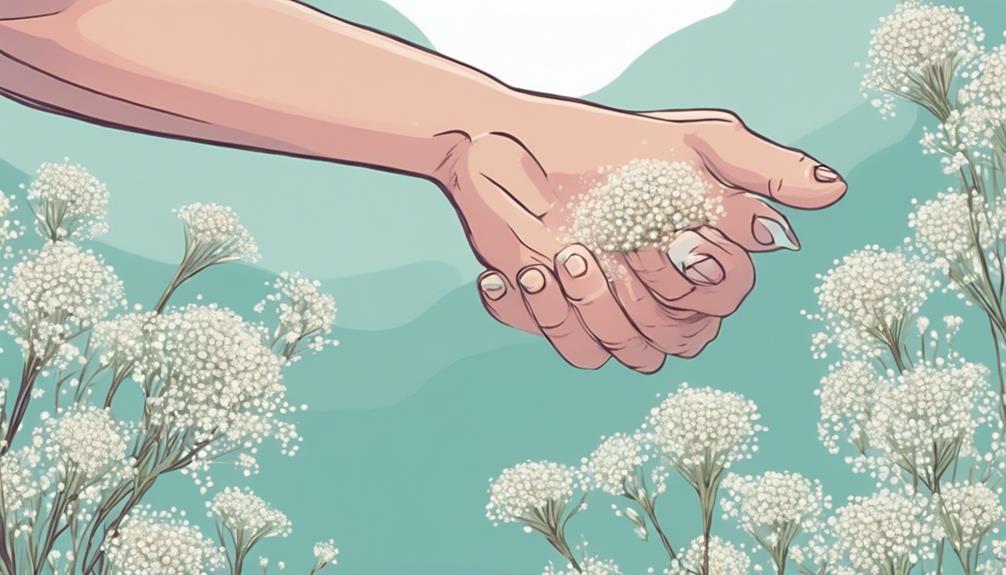To assist your infant with an upset stomach, watch for signs such as crying, crankiness, or bringing legs up to the chest. Consider trying gentle solutions like baby massage or moving their legs in a bicycle motion. If symptoms worsen to include vomiting or fever, seek medical assistance promptly. Comfort your baby with practices such as swaddling, using white noise, or giving a pacifier. To prevent future stomach issues, avoid overfeeding and ensure a proper latch while breastfeeding. It is crucial to consult with a healthcare professional. Remember, pinpointing the causes and treatments for your baby’s stomach ache is crucial for providing them with comfort and relief.
Key Takeaways
- Try infant massage or bicycle legs exercises for relief.
- Ensure proper latch or formula selection for comfort.
- Use swaddling, white noise, or pacifier for soothing.
- Avoid gas-inducing foods and offer prune juice for constipation.
- Prevent issues with proper feeding techniques and schedules.
Identifying Baby's Stomach Ache Symptoms
To identify your baby's stomach ache symptoms, observe for signs like excessive crying, fussiness, and refusal to eat or sleep.
Infants experiencing abdominal discomfort may exhibit behaviors such as pulling their legs to their chest or passing gas frequently. Additionally, changes in feeding patterns or overall behavior could indicate a stomach ache in your baby.
Keep an eye out for symptoms like diarrhea, vomiting, and general stomach discomfort, as these could be signs of tummy troubles.
If your baby shows persistent or worsening stomach ache symptoms, or if these symptoms are accompanied by other concerning signs like fever or dehydration, it's important to consult a healthcare provider promptly.
Home Remedies for Baby's Stomach Ache
Consider incorporating infant massage and bicycle legs exercises as effective home remedies for your baby's stomach ache. These techniques can help relieve pain and discomfort by promoting digestion and reducing gas in your child's tummy. Additionally, choosing the right formula that's gentle on the stomach can aid in easing digestive issues.
When breastfeeding, paying attention to latch quality is vital as a proper latch can prevent excess air intake, which may contribute to stomachaches in infants. If you're nursing and experiencing an oversupply of milk, managing this can help reduce gassiness in your baby and alleviate stomach discomfort.
Other soothing strategies include swaddling your baby, using white noise as a distraction, and offering a pacifier. These simple home remedies can provide relief for your little one's stomach ache and help them feel more comfortable. Remember to consult with your pediatrician if the pain persists or if you have any concerns about your baby's stomach health.
When to Seek Medical Help

If your baby is experiencing a sudden or persistent stomachache causing distress, it's important to seek medical help promptly. Here are some signs that indicate when you should see a doctor for your child's tummy troubles:
- Contact a healthcare provider if your baby experiences symptoms like vomiting, fever, or headache along with the stomachache.
- Look out for signs of infections such as strep throat or urinary tract infection, which may require medical attention.
- Rare causes of stomach pain in babies like appendicitis or intestinal blockage should prompt a visit to the doctor.
It's essential to be aware of any unusual symptoms or behaviors in your baby when dealing with an upset tummy. If you suspect something more serious than a typical stomachache, seeking medical advice promptly can help make sure your child receives the necessary care and treatment.
Tips for Soothing Baby's Stomach Ache
Swaddle your baby in a blanket for comfort and to help alleviate symptoms of a stomach ache. The gentle pressure from swaddling can provide a sense of security and calmness, which may help soothe your baby during this uncomfortable time.
Additionally, using white noise, such as a fan or a white noise machine, can act as a distraction and create a soothing environment for your baby, potentially easing their stomach ache.
Offering a pacifier to your baby can be beneficial as the sucking and swallowing motion can help in calming stomach discomfort. For breastfeeding mothers, being mindful of foods that may cause gas can reduce the chances of your baby experiencing stomach aches. Avoiding gas-inducing foods like broccoli or beans can be helpful.
If your baby is suffering from constipation, giving them prune juice can aid in relieving constipation and easing stomach discomfort. Remember, always consult with your healthcare provider for personalized advice on how to best soothe your baby's stomach ache.
Preventing Baby's Stomach Aches

To avoid baby's stomach aches, make sure you avoid overfeeding and burp your baby frequently during feedings. Proper feeding practices can greatly reduce the chances of stomach discomfort.
When caring for your baby, remember to:
- Avoid Overfeeding: Feeding your baby too much can overwhelm their digestive system, leading to stomach aches and indigestion.
- Frequent Burping: Burping your baby during and after feedings helps release trapped gas, decreasing the likelihood of stomach discomfort.
- Proper Positioning: Ensure your baby is in an upright position while feeding to prevent swallowing air, which can contribute to stomach aches.
In addition to these practices, choosing a gentle and easily digestible formula for bottle-fed babies, maintaining a consistent feeding schedule, and gradually introducing new foods can also help prevent upset stomachs in babies.
Frequently Asked Questions
How to Soothe an Infant Stomach Ache?
To soothe an infant's stomach ache, swaddle them in a blanket for comfort. Use white noise like a fan or noise machine to distract. Offering a pacifier can help calm them. Avoid gassy foods if breastfeeding. Prune juice can relieve constipation.
What to Give When Baby's Stomach Is Upset?
When baby's belly's bothering them, give gentle liquids like water or diluted juice to soothe. Breastfeed or offer formula for comfort. Remember, no solids until pain fades. Always check with a doctor before trying new remedies.
How to Tell if Baby's Stomach Hurts?
Pay attention to signs like fussiness, crying, or changes in feeding. Look for symptoms like diarrhea, vomiting, bloated belly, or excessive gas. Seek medical help if baby shows persistent discomfort such as prolonged crying or difficulty soothing.
What Home Remedy Can I Give My Baby to Clean His Stomach?
To clean your baby's stomach naturally, give them prune juice. It's fiber-rich and helps with digestion. Safe in small amounts, but ask your pediatrician first. Prune juice is a gentle laxative for constipation.
Conclusion
In the journey of soothing your baby's stomach ache, remember to be patient and attentive to their needs. Like a gentle breeze calming the storm, your care and love will guide them through any discomfort.
Stay informed, stay prepared, and most importantly, stay comforting. Your little one is counting on you to provide the care they need to feel better.
You've got this, parent.








